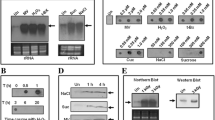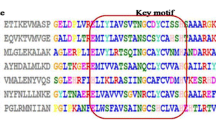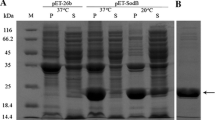Abstract
Peroxiredoxins (Prxs), proteins that detoxify peroxides, are ubiquitously present in all organisms. In the cyanobacterium Anabaena PCC7120, ORF alr4642 encodes a protein that shows homology to Prx-like family of Prxs. The role of Alr4642 in the oxidative stress management of Anabaena was evaluated in this study. Sequence analysis showed the presence of another methionine residue, 35 amino acids away from the first annotated methionine. The similarity of Alr4642 with the other Prx-like proteins was observed only from the second methionine residue. When over-expressed in Escherichia coli, both Alr4642 and AlrT4642 (truncated Alr4642, initiating from the second methionine) remained insoluble and could not be purified. Interestingly, expression of the complete alr4642 ORF in Anabaena led to the production of the AlrT4642 protein, suggesting that the second ATG was the actual in vivo start codon of alr4642 in Anabaena. When over-expressed in Anabaena, AlrT4642 (with a C-terminal His-tag) remained soluble and could be purified by affinity chromatography. The purified AlrT4642 protected the plasmid DNA from oxidative damage whereas Anabaena cells over-expressing AlrT4642 showed improved resistance to H2O2 than the wild type. These data indicate that AlrT4642 is indeed an antioxidant protein that is capable of defending Anabaena from oxidative stress and suggest that over-expression of Prx-like proteins may be an effective method to improve stress resistance in cyanobacteria. This is the first report wherein a Prx-like family protein has been functionally characterized.





Similar content being viewed by others
References
Agrawal C, Sen S, Singh S, Rai S, Singh PK, Singh VK, Rai LC (2014) Comparative proteomics reveals association of early accumulated proteins in conferring butachlor tolerance in three N2-fixing Anabaena spp. J Proteomics 96:271–290
Alahari A, Apte SK (1998) Pleiotropic effects of potassium deficiency in a heterocystous, nitrogen-fixing cyanobacterium, Anabaena torulosa. Microbiology 144:1557–1563
Allen JF, Martin W (2007) Evolutionary biology: out of thin air. Nature 445:610–612
Altschul SF, Gish W, Miller W, Meyera MW, Lipman DJ (1990) Basic local alignment search tool. J Mol Biol 215:403–410
Asada K, Kiso K, Yoshikawa K (1974) Reduction of molecular oxygen by spinach chloroplast on illumination. J Biol Chem 249:2175–2181
Banerjee M, Ballal A, Apte SK (2012a) Mn-catalase (Alr0998) protects the photosynthetic, nitrogen-fixing cyanobacterium Anabaena PCC7120 from oxidative stress. Environ Microbiol 14:2891–2900
Banerjee M, Ballal A, Apte SK (2012b) A novel glutaredoxin domain-containing peroxiredoxin ‘All1541’ protects the N2-fixing cyanobacterium Anabaena PCC 7120 from oxidative stress. Biochem J 442:671–680
Banerjee M, Raghvan PS, Ballal A, Rajaram H, Apte SK (2013) Oxidative stress management in the filamentous heterocystous, diazotrophic cyanobacterium, Anabaena PCC7120. Photosynth Res 118:59–70
Bernroitner M, Zamocky M, Furtmüller PG, Peschek GA, Obinger C (2009) Occurrence, phylogeny, structure, and function of catalases and peroxidases in cyanobacteria. J Exp Bot 60:423–440
Bihani SC, Chakravarty D, Ballal A (2013) Purification, crystallization and preliminary crystallographic analysis of KatB, a manganese catalase from Anabaena PCC 7120. Acta Crystallogr Sect F: Struct Biol Cryst Commun 69:1299–1302
Cha MK, Hong SK, Kim IH (2007) Four thiol peroxideses contain a conserved GCT catalytic motif and act as a versatile array of lipid peroxidases in Anabaena sp. PCC7120. Free Radic Biol Med 42:1736–1748
Chaurasia AK, Parasnis A, Apte SK (2008) An integrative expression vector for strain improvement and environmental applications of the nitrogen fixing cyanobacterium, Anabaena sp. strain PCC7120. J Microbiol Methods 73:133–141
Choudhury S, Panda P, Sahoo L (2013) Reactive oxygen species signaling in plants under abiotic stress. Plant Signal Behav 8:e23681
Collen J, Del Rio MJ, García-Reina G, Pedersén M (1995) Photosynthetic production of hydrogen peroxide by Ulva rigida C. Ag (Chlorophyta). Planta 196:225–230
Cui H, Wang Y, Wang Y, Qin S (2012) Genome-wide analysis of putative peroxiredoxin in unicellular and filamentous cyanobacteria. BMC Evol Biol 12:220
Dadheech N (2010) Desiccation tolerance in cyanobacteria. Afr J Microbiol Res 4:1584–1593
Dietz KJ (2011) Peroxiredoxins in plants and cyanobacteria. Antioxid Redox Signal 15:1129–1159
Drabakova M, Matthijs HCP, Admiraal W, Marsalek B (2007) Selective effects of H2O2 on cyanobacterial photosynthesis. Photosynthetica 45:363–369
Elhai J, Vepritskiy A, Muro-Pastor AM, Flores E, Wolk CP (1997) Reduction of conjugal transfer efficiency by three restriction activities of Anabaena sp. strain PCC 7120. J Bacteriol 179:1998–2005
Halliwell B, Gutteridge JMC (1986) Oxygen free radicals and iron in relation to biology and medicine: some problems and concepts. Arch Biochem Biophys 246:501–514
Imlay JA (2003) Pathways of oxidative damage. Annu Rev Microbiol 57:395–418
Kaneko T, Nakamura Y, Wolk CP (2001) Complete genomic sequence of the filamentous nitrogen-fixing cyanobacterium Anabaena sp. strain PCC 7120. DNA Res 8:205–213
Laemmli UK (1970) Cleavage of structural proteins during the assembly of the head of bacteriophage T4. Nature 227:680–685
Latifi A, Ruiz M, Jeanjean R, Zhang CC (2007) PrxQ-A, a member of the peroxiredoxin Q family, plays a major role in defense against oxidative stress in the cyanobacterium Anabaena sp. strain PCC7120. Free Radic Biol Med 42:424–431
Mackinney G (1941) Absorption of light by chlorophyll solutions. J Biol Chem 140:315–322
Mazón G, Lucena JM, Campoy S, Fernández de Henestrosa AR, Candau P, Barbé J (2004) LexA-binding sequences in Gram-positive and cyanobacteria are closely related. Mol Genet Genomics 271:40–49
Nishiyama Y, Allakhverdiev SI, Murata N (2006) A new paradigm for the action of reactive oxygen species in the photoinhibition of photosystem II. Biochim Biophys Acta 1757:742–749
Panda B, Basu B, Rajaram H, Apte SK (2014) Methyl viologen responsive proteome dynamics of Anabaena sp. strain PCC7120. Proteomics 14:1895–1904
Pascual MB, Cabana AM, Florencio FJ, Lindahl M, Cejudo FJ (2010) Overoxidation of 2-Cys peroxiredoxin in prokaryotes: cyanobacterial 2-Cys peroxiredoxins sensitive to oxidative stress. J Biol Chem 285:34485–34492
Qian H, Yu S, Sun Z, Xie X, Liu W et al (2010) Effects of copper sulfate, hydrogen peroxide and N-phenyl-2-naphthylamine on oxidative stress and the expression of genes involved photosynthesis and microcystin disposition in Microcystis aeruginosa. Aquat Toxicol 95:405–412
Schultz J, Milpetz F, Bork P, Ponting CP (1998) SMART, a simple modular architecture research tool: identification of signaling domains. Proc Natl Acad Sci U S A 95:5857–5864
Storz G, Imlay JA (1999) Oxidative stress. Curr Opin Microbiol 2:188–194
Tripathi B, Bhatt I, Dietz KJ (2009) Peroxiredoxins: a less studied component of hydrogen peroxide detoxification in photosynthetic organisms. The function of peroxiredoxins in plant organelle redox metabolism. Protoplasma 235:3–15
Venkatraman GS (1979) Algal inoculations in rice fields. In: Brady NC (ed) Nitrogen and rice. International Rice Research Institute, Los Banos, pp 311–321
Wood ZA, Schröder E, Robin-Harris J, Poole LB (2003) Structure, mechanism and regulation of peroxiredoxins. Trends Biochem Sci 28:32–40
Yoon HS, Golden JW (1998) Heterocyst pattern formation is controlled by a diffusible peptide. Science 282:935–938
Zamocky M, Furtmüller PG, Obinger C (2008) Evolution of catalases from bacteria to humans. Antioxid Redox Signal 10:1527–1548
Zhao W, Guo Q, Zhao J (2007) A membrane-associated Mn-superoxide dismutase protects the photosynthetic apparatus and nitrogenase from oxidative damage in the cyanobacterium Anabaena sp. PCC 7120. Plant Cell Physiol 48:563–572
Acknowledgments
Fellowship provided by Homi Bhabha National Institute to Vijay Tailor is gratefully acknowledged. We wish to thank Dr. S. K. Apte for constant encouragement and Dr. Manisha Banerjee for the helpful suggestions during the course of this study. This work was funded by the XI plan project of DAE, India.
Author information
Authors and Affiliations
Corresponding author
Rights and permissions
About this article
Cite this article
Tailor, V., Ballal, A. Over-expression of Alr4642, a novel Prx-like peroxiredoxin, defends the cyanobacterium Anabaena PCC7120 from oxidative stress. J Appl Phycol 27, 2261–2270 (2015). https://doi.org/10.1007/s10811-014-0503-3
Received:
Revised:
Accepted:
Published:
Issue Date:
DOI: https://doi.org/10.1007/s10811-014-0503-3




